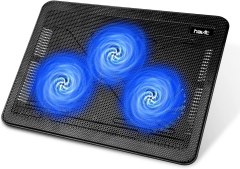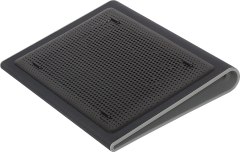
A solid pick if you want a highly rated cooling pad recognized for its simplicity and affordability.
A solid pick if you want a highly rated cooling pad recognized for its simplicity and affordability.
Fans are quiet. Comes with a built-in LED light and extra USB ports for further device use. Tilt feature can raise your computer by 1 inch, making it comfortable for typing. A lightweight and portable product.
Has trouble fitting 17-inch laptops. A few buyers complained the fans run a little slow.

A well-rounded product with an affordable price tag, this cooling fan provides deluxe accessories at a fraction of the cost.
A well-rounded product with an affordable price tag, this cooling fan provides deluxe accessories at a fraction of the cost.
Shaped to elevate laptop for ease of use. Includes an anti-slip band which keeps your laptop firmly in place. Soft border feels nice on wrists and forearms. Includes an extra USB port. LED indicator informs user when the unit is running.
Fan can be a bit noisy. Only fits laptops up to 15 inches well.

An understated design lets this pad fit into an office setting.
An understated design lets this pad fit into an office setting.
A businesslike, workplace-appropriate cooling pad with two quiet fans and a hideaway USB power cable. A neoprene-lined base adds comfort when used directly on the lap, and four rubber stops hold laptop in place.
No extra USB ports. There are only two fans, and the height is not adjustable. The USB cable may not reach laptops with ports on the opposite side.

Laptop and console gamers will appreciate this cooling pad’s features.
Laptop and console gamers will appreciate this cooling pad’s features.
Four large 120mm fans spin at up to 1200 rpm for powerful ventilation. Cools gaming laptops as well as consoles such as PlayStation and Xbox. Comes with a detachable, braided USB power cable. The surface is metal mesh with retractable stoppers.
The metal surface doesn’t grip laptops, and some find the plastic frame fragile.

Five fans can be used in three combinations in this power-user’s cooling pad.
Five fans can be used in three combinations in this power-user’s cooling pad.
Well-regarded cooling pad boasts four 70mm and one 140mm fan, with two independent on/off switches for three cooling options, and six height adjustment angles. The back-mounted USB cable is built in, with two USB ports for additional connectivity.
Some users note the bottom piece can crack. The metal surface doesn’t grip laptops as securely as other materials.

We recommend these products based on an intensive research process that's designed to cut through the noise and find the top products in this space. Guided by experts, we spend hours looking into the factors that matter, to bring you these selections.

Heat is one of the biggest factors manufacturers must account for when designing a computer. As processors have evolved, added more cores and become more powerful, the amount of heat generated by them has increased. In addition to the CPU, graphics processing units (GPU) have grown in power almost exponentially. As a result, in many modern computers, GPUs can put off as much or more heat than the CPU.
Laptops have few options in terms of naturally cooling themselves. Once you add memory, a hard drive, ports, keyboards and an optical drive, there isn’t much room left for fans or heat sinks. To make matters worse, the components are crammed into a tight space where there’s very little airflow. Power is also a limitation unique to laptops.
These limitations have real-world implications, especially for heavy users. Some laptops with high-end chips have been shown to perform worse under a heavy load than models using less powerful chips due to the high-end CPU slowing down, or throttling, to reduce heat. If you use a laptop and are worried about excess heat, a laptop cooling pad may be an option to help keep your computer cool.

The biggest factor to consider when looking at a laptop cooling pad is how you use your computer. If you mainly use your laptop for email, web browsing, and working with documents, there’s a good chance you don’t need a heavy-duty option. If you use your laptop for graphics, video, or gaming, you may need to look for a more robust model.
Another thing to consider when purchasing a cooling pad is the climate and temperature where you live. If you live in a warmer climate or don’t use air conditioning, you’ll need a more powerful cooling pad to be effective than if you live in a colder climate or run your air conditioning all the time.
How easy the cooling pad is to move around may be a concern to some users. While some cooling pads are designed to be used exclusively on a desk or similar flat surface, others are designed to be taken with you and can even be used on your lap.
The sound level should factor into your decision when shopping for a cooling pad. Many laptop fans can be relatively loud by themselves, so you should try to find a cooling pad that has silent fans.




















Look for a model that has the option to use an external power source. Almost all cooling pads rely on power from one of your computer’s USB ports. Many units also include support for an external power source, giving you additional flexibility.
Because cooling pads often use one of your USB ports, some pads come with an integrated USB hub. If you’re already USB-poor, this is a good option to expand your usable ports.
Many cooling pads come with feet or some way to change the viewing angle. Compared to desktop computers, laptops have never been known for good ergonomics. A desktop separates the computer’s components so each one can be placed at the optimal position and angle, as opposed to a laptop where you have a single focal point. If you spend hours a day using your laptop, choose a cooling pad that offers multiple viewing angles to help improve ergonomics and alleviate neck strain.
Cooling pads measure the amount of air pushed by the fans in cubic feet per minute (CFM). For best results, try to find a model with a high CFM rating. The more air its fans push, the more heat is transferred and the more it will cool your laptop.
Look for a cooling pad that has multiple ventilation openings and airflow channels. This will provide more flexibility if you want to use your laptop in an environment where one or more channels may be blocked, such as on the couch or laying in bed with blankets.
Some high-end pads include a display that gives you control over the fans. You can put them in automatic, or lock them on high or maximum cooling. Some models also include temperature sensors to help you pinpoint where your laptop is the hottest.
Entry-level models cost $20 to $25 and include one or two fans.
In this range, models cost $25 to $35 and will often include additional fans, as well as upgraded materials to make the pad more comfortable to use.
High-end units will range from $35 to $100 or more. These units have multiple fans, USB hubs, multiple viewing angles and premium materials. These units are ideal for gamers and heavy users who need the most cooling and options available.
Although multiple fans can mean more airflow, that’s not always the case. In some cases, a single large fan may provide more airflow than multiple smaller fans. When in doubt, check the CFM rating to see what models provides the most airflow.
While rubber feet that add additional clearance are good if you plan on using a laptop cooler on your desk or flat surface, they can be uncomfortable while using it on your lap. If that’s the case, try finding a model with collapsible feet or a model without feet.
Some cooling pads have fastening methods to keep your laptop secure. This is a useful feature if you use your pad on the go.
Many laptops get uncomfortably warm to the touch. In addition to keeping your laptop cool, a cooling pad is a good option to help keep you comfortable while using it.

A. That depends largely on the individual model and the features it has. For best results, try to buy a cooling pad that allows you to control the fans so you can turn them off during light use.
A. Some models will. If one doesn’t, and it doesn’t have an off switch, simply unplug it from the computer’s USB port to turn it off.
A. Much of that depends on your laptop and the cooling pad. Some users report a few degrees difference, while others see temperatures as much as 30 degrees cooler.
A. Every little bit helps. Because of the nature of laptop design, the cooler you can make them the better. The hotter a laptop runs, the more its internal fans have to work and the shorter its lifespan will be.
Get emails you’ll love.
Learn about the products you’re wondering if you should buy and get advice on using your latest purchases.
